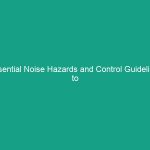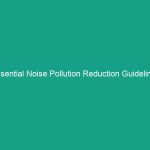“`html
Essential Guidelines to Prevent Noise Induced Hearing Loss on the Job
Good morning team,
Today, we are going to discuss an important topic that affects many workplaces—noise-induced hearing loss (NIHL). This Toolbox Talk will cover essential guidelines to prevent NIHL on the job, ensuring that we all understand the risks and how to protect ourselves effectively.
Hearing is one of our most valuable senses, and protecting it should be a top priority for everyone. Noise-induced hearing loss can lead to permanent damage, affecting not only our work but also our personal lives. Let’s dive in and learn how we can safeguard our hearing while on the job.
Understanding Noise Induced Hearing Loss (NIHL)
Noise-induced hearing loss occurs when you are exposed to loud sounds over an extended period. This exposure can damage the hair cells in the inner ear, leading to irreversible hearing impairment. It is crucial to recognize that NIHL is preventable, mainly through proper Safety Measures and awareness.
Many employees may think, “It won’t happen to me,” but the reality is that even moderate noise levels can accumulate and lead to significant hearing issues over time. The impact of NIHL can disrupt communication, reduce productivity, and pose Safety risks in the workplace. Understanding this risk is the first step toward protecting ourselves.
Key Hazards, Risks, and Safety Considerations
Several Hazards and risks can lead to noise-induced hearing loss on the job, including:
- High Decibel Levels: Sounds above 85 decibels can cause hearing damage over time. Common sources include machinery, power tools, and loud equipment.
- Prolonged Exposure: Even moderate noise levels can become dangerous if exposure is continuous. For instance, a noisy Environment can lead to cumulative damage.
- Lack of Awareness: Many employees may not realize the potential dangers of noise exposure or how to protect themselves.
If these risks are ignored, the consequences can be severe. Employees may experience difficulty hearing, communication problems, and even social isolation due to hearing loss. Therefore, it is vital to take noise exposure seriously and implement preventive measures.
Best Practices, Procedures, & Actionable Advice
To effectively prevent noise-induced hearing loss, follow these essential guidelines:
1. Identify the Noise Sources
Conduct a noise audit in your work environment to identify sources of hazardous noise. Look for machinery, tools, or processes that generate high decibel levels. This step is crucial for understanding where the risks lie.
2. Use Personal Protective Equipment (PPE)
Always wear appropriate hearing protection when working in noisy areas. Options include:
- Earmuffs: Provide a good seal around the ears and can reduce noise levels significantly.
- Earplugs: A more discreet option that can also effectively lower noise exposure.
Ensure that the PPE fits correctly and is suitable for the level of noise exposure you encounter.
3. Implement Engineering Controls
Whenever possible, use engineering controls to reduce noise exposure. This may involve:
- Installing sound barriers or enclosures around noisy machinery.
- Using quieter equipment or tools designed to minimize noise.
- Regular Maintenance of machinery to keep them running smoothly and quietly.
4. Limit Exposure Time
Rotate tasks among employees to limit the amount of time each individual spends in noisy environments. This practice can significantly reduce the risk of hearing loss.
5. Conduct Training and Awareness Programs
Regularly educate employees about the risks of noise exposure and the importance of hearing conservation practices. Training should cover:
- The dangers of noise-induced hearing loss.
- How to properly use hearing protection equipment.
- How to recognize early signs of hearing loss.
6. Regular Hearing Tests
Implement routine hearing tests for employees who are regularly exposed to high noise levels. Early detection of hearing loss can lead to timely intervention and Prevention of further damage.
Regulations, Standards, and Compliance
It is essential to be aware of the Regulations and Standards in place to protect employees from noise-induced hearing loss. OSHA (Occupational Safety and Health Administration) has established regulations that require employers to monitor noise levels and provide hearing conservation programs when noise exceeds 85 decibels.
Compliance with these regulations is critical not only for protecting employees but also for ensuring a safe and healthy work environment. Employers are responsible for providing the necessary training, PPE, and monitoring of noise exposure levels.
Employee Engagement & Discussion
Now that we’ve covered the essential guidelines to prevent noise-induced hearing loss, let’s engage in a discussion. Here are a few questions to consider:
- What safety challenges have you encountered related to noise exposure in your role?
- Do you feel you have adequate training on how to protect your hearing?
- What suggestions do you have for improving our workplace’s noise Safety Measures?
Feel free to share your thoughts or experiences, as your input is invaluable in creating a safer work environment for everyone.
Conclusion & Key Takeaways
To summarize, noise-induced hearing loss is a serious risk that we must address proactively. By understanding the hazards, following Best Practices, and engaging in open discussions about safety, we can significantly reduce our risk of hearing loss on the job.
Remember, protecting your hearing is not just about compliance; it’s about valuing your health and well-being. Let’s commit to prioritizing safety and looking out for one another.
Thank you for your attention and dedication to maintaining a safe workplace. Together, we can prevent noise-induced hearing loss and foster a healthier environment for all.
“`


